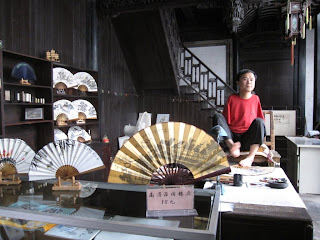





Slowly, Slowly
29 September 2010
Lhasa, Tibet Autonomous Region, China
There are 890 UNESCO World Heritage Sites in the world. This morning I saw my 29th, “the Historical Ensemble of the Potala Palace.” Potala Palace and Drepung Monastery.
When I woke up, I felt the altitude. I had taken my first Diamoxx on the plane. I think the Diamoxx is helping because I haven’t yet felt like I did when I got altitude sickness in Peru, but it certainly is no golden ticket. Before we left the Cool Yak Hotel, I went back upstairs to grab something and my head started throbbing.
So, as we stood at the base of Potala Palace, looking up, I asked our guide, Bemba, “How many elevators are there?”
He didn’t get it.
The seven of us climbed the 460 steps at varying speed. I tied for last. One of my companions who had recently climbed Mount Kilimanjaro told us their guides taught them a mantra for climbing the mountain without inciting the evils of altitude sickness: “Poli, poli.”
“Slowly, slowly.”
Slowly, slowly, I reached the top: 3,490 meters.
Our guide’s English made the laundry list of Buddhas and Boddhivistas extremely hard to follow, but the chambers were beautiful. We slipped in and out of them through colorful door curtains covered in geometric doodles, passing over terraces and into yet another chamber of another blessed being.
<>
On the way out, he explained ༀམཎིཔདྨེཧཱུྃ། or “om mani beh meh hung.” Bemba’s translation left me thinking it meant something along the lines of a plea not to be sent to hell. After looking it up in all-knowing Wikipedia, I’m not sure it was so simple, but at any rate, it is a beautiful spiritual phrase plastered and heard all over Tibet.
I asked Bemba to take us out to a Tibetan club, and, oh, did he! Yves ordered a bottle of whiskey, and Bemba had a shot but later blamed that one taste for his entire hangover. The bottle of whiskey was befriended by several cases of Tibetan beer. Bemba invited several Tibetan girls to keep us company, and my Brazilian friend resorted to tickling as a flirting tactic after none of his languages made any headway.
The club had a show, which was performed in front of an image of Potala Palace that covered the wall from floor to ceiling. First there were traditional Tibetan dances, with women and men dancing in tandem in wildly colored outfits and sometimes exceptional hats. One of the hats looked like a dislodged part of Angkor Wat. Then singular singers took turns singing songs in Tibetan. When a singer sings a song you really like in Memphis neighborhood blues clubs, you walk up to the singer while they are singing and hand them cash. In Tibet, you walk up to them in the midst of their song, but you drape a silvery Tibetan prayer scarf around their shoulders. The best singer of the night finished what seemed to be a classic with about a dozen scarves draping him.
Both the acts and the singers were really good. But neither were anywhere near as good as the Tibetan square dancing that followed.
The moves were surprisingly hard, but the real Tibetans were all but ignoring the imposter Westerners, so I was hardly noticed when I really stared and tried to copy my Tibetan brethren. Finally I got one, though it was by far the easiest of the night and made the Macarena look like a Viennese waltz. Regardless, I cannot describe how upset I was when my companions led me off the floor to go home right after I’d conquered my first Tibetan dance moves.
Pictures: Potala Palace (3: front, back, and back with prayerwheels); Drepung Monastery (3: roof, colorful columns, monk with gong); Tibetan ladies chatting in the market; om mani beh meh hung in a wall near Potala Palace; Tibetan nightclub (2: Tibetan dance, Tibetan singer just given prayer scarf) --- Unfortunately Tibetan square dancing is not pictured.




















